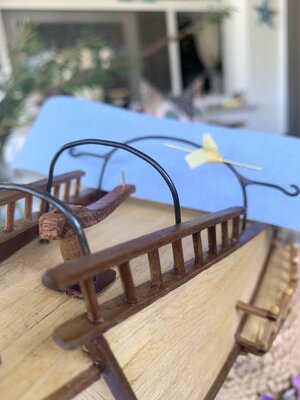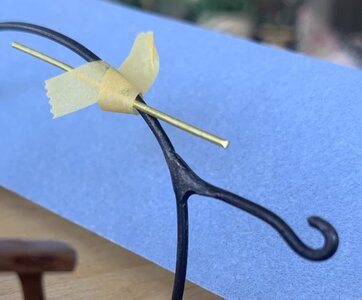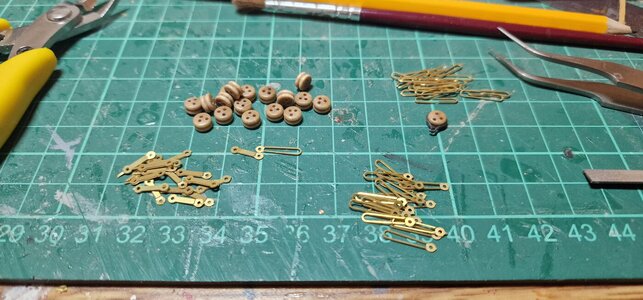You are using an out of date browser. It may not display this or other websites correctly.
You should upgrade or use an alternative browser.
You should upgrade or use an alternative browser.
Advice Required
- Thread starter Tommy Bowler
- Start date
- Watchers 12
Should read 'my' kit, not 'me'. Auto correct at it's best
Hi Tommy
Birch wood Casey brass black is my favourite solution. Bit of a learning curve to use but far nicer than paint
Birch wood Casey brass black is my favourite solution. Bit of a learning curve to use but far nicer than paint
I will have to hunt for some
I got mine mail order, only option unless you live near a decent gun shop
I have found some on ebay
That's what I found. I will give it a try
I can also recommended Brass Black, is available in several places on the internet.
Good luck!
Good luck!
I have some on order. Thanks for the information
I use selenium dioxide (selenic acid) diluted solution.It is used mostly by antique lamps or furniture accesories producers out of brass or copper.It is very much cheaper than the prepared products on the market.If you have a connection to such people a 50 ml conc product is sufficient for your life time modeling.you put your brass product in and shake (you can also stir ofcourse) 5 to 30 secs depending on darkening degree take out and rub the product.Welded parts also darken.
You can also treat allredy mounted brass parts bringing in contact the brass areas with SO with a brush or Q-tip and then rub them.the treated surface must be free of any varnish or glueing agent.The
attachment shows treated and not treated brass wire
Good Luck &Kind Regards


You can also treat allredy mounted brass parts bringing in contact the brass areas with SO with a brush or Q-tip and then rub them.the treated surface must be free of any varnish or glueing agent.The
attachment shows treated and not treated brass wire
Good Luck &Kind Regards


I use this stuff too. I rinse off the brass parts in acetone, then with water, and dry them. Then I submerge them in brass black and swirl them around for about a minute. Then drain them through a paper towel and rinse them with water. Next day when they're good and dry, I put them in a jar with some sand and mix them up, essentially sanding them. Works pretty good.
Korsan,
if you are willing, can you provide your recipe and amounts to make your solution. In other words, I do assume that you will mix the selenium oxide with water? and what ratios?
Kindly
if you are willing, can you provide your recipe and amounts to make your solution. In other words, I do assume that you will mix the selenium oxide with water? and what ratios?
Kindly
I too speak Pirate- however I shiver me timbers is fine. It's all good.Should read 'my' kit, not 'me'. Auto correct at it's best
- Joined
- Jun 10, 2023
- Messages
- 2
- Points
- 3
I use hydrogen peroxide contact lens cleaner 5% and white vinegar. 50/50 mix. It naturally weathers brass and copper parts. Try 5mins submersion and see how it goes.
Is this too blacken the parts or to clean them for blackening?I use hydrogen peroxide contact lens cleaner 5% and white vinegar. 50/50 mix. It naturally weathers brass and copper parts. Try 5mins submersion and see how it goes.
Hi DonnieKorsan,
if you are willing, can you provide your recipe and amounts to make your solution. In other words, I do assume that you will mix the selenium oxide with water? and what ratios?
Kindly
The mixing ratio SO/W can vary from 1/5 to 1/20. The much diluted solution gives you much time to control the blackening degree and so the oxide layer on the metal polished by rubbing (with a cloth piece or glove)the surface will became smooth and glides and looks gun metal similar.If you are not satisfied with the effect you can immerse and treat it again.If you take concentrated version the oxide layer builds very quick ( within seconds) to a dark intensive black and is thick and brittle ,also damages the surface of the brass and splitters while rubbing. The same situation occurs also if you treat the brass 1 or 2 minutes in the diluted solution.Another important point is the surface of to be treated brass should be free of any contact blocking product like glue,varnish etc.Sanding (800 -1000 or treating with volatile solvents (toluol acetone etc) helps to clean the surfaces before trratment.I hope this info is the answer to your question
Stay Healthy and Kind Regards

PS: Do not throw away your used solution you can use it many times. If too much precipitate you can filter it
- Joined
- Jun 10, 2023
- Messages
- 2
- Points
- 3
It will do both. A quick dip and wipe of will clean but I use it for weathering/oxidizing brass. Have a read of this it might help. https://inmyownstyle.com/how-to-age-brass-in-less-than-5-minutes.html Make sure you run test pieces(I use old brass hinges etc) before deciding on the final desired finish. I came across this as I am building a scratch built 17th C pirate boat based, on the apostol felipe, on a limited budget. I don't want bright shining cannons and bits so investigated weathering without spend £15 of chemicals. If you want BLACK then I think you will have to use chemicals. My cannons and bits are a sort of light bronze colour now. Give it a try on a scrap piece even if its not what you want for this job, it may come in really handy in the future. Good luck!Is this too blacken the parts or to clean them for blackening?








